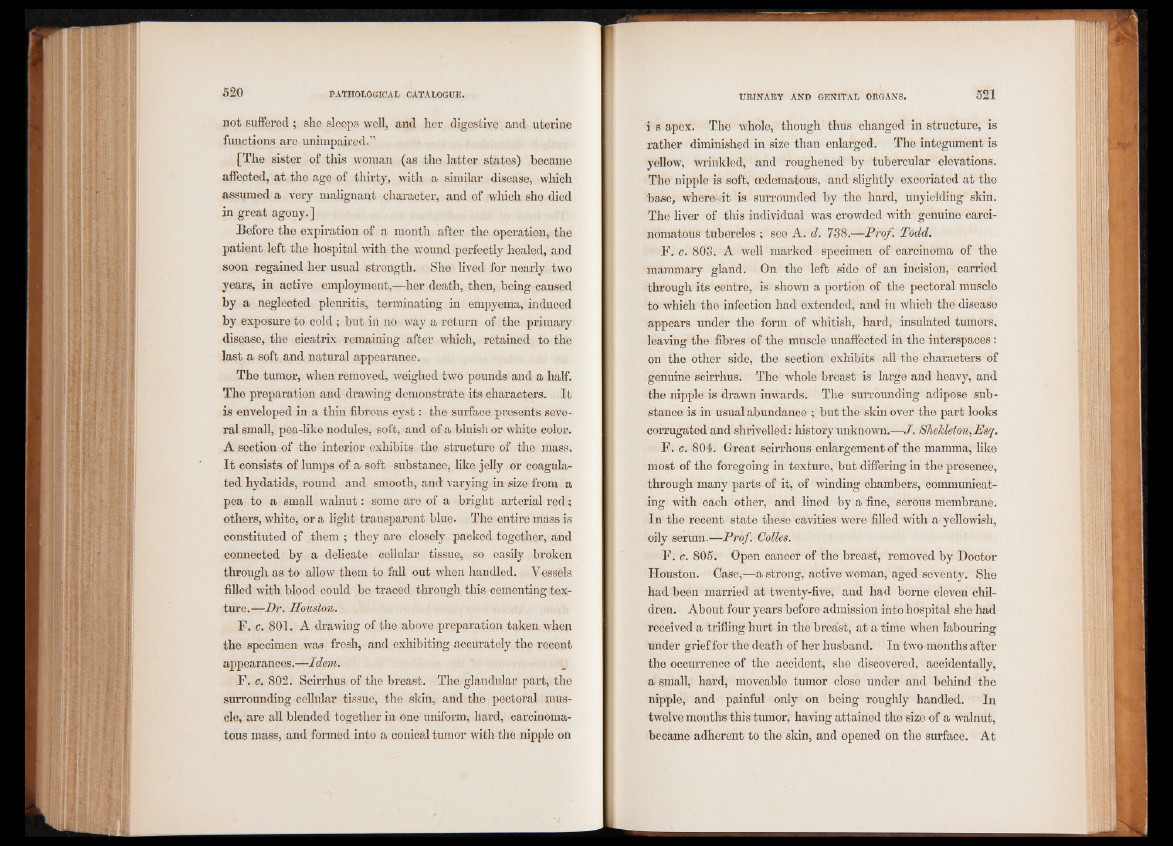
not suffered ; she sleeps well, and her digestive and uterine
functions are unimpaired.-”
[The sister of this woman (as the latter states) became
affected, at the age of thirty, with a similar disease, which
assumed a very malignant character, and of which she died
in great agony.]
Before the expiration of a month after the operation, the
patient left the hospital with the wound perfectly healed, and
soon regained her usual strength. She lived for nearly two
years, in active employment,—her death, then, being caused
by a neglected pleuritis, terminating in empyema, induced
by exposure to cold ; but in no way a return of the primary
disease, the cicatrix remaining after which, retained to the
last a soft and natural appearance.
The tumor, when removed, weighed two pounds and a half.
The preparation and drawing demonstrate its characters. It
is enveloped in a thin fibrous cyst: the surface presents several
small, pea-like nodules, soft, and of a bluish or white color.
A section of the interior exhibits the structure of the mass.
It consists of lumps of a soft substance, like jelly or coagulated
hydatids, round and smooth, and varying in size from a
pea to a small walnut: some are of a bright arterial red;
others, white, ora light transparent blue. The entire mass is
constituted of them ; they are closely packed together, and
connected by a delicate cellular tissue, so easily broken
through a3 to allow them to fall out when handled. Vessels
filled with blood could be traced through this cementing texture.
—Dr. Houston.
F. c. 801. A drawing of the above preparation taken when
the specimen was fresh, and exhibiting accurately the recent
appearances.—Idem.
F. c. 802. Scirrhus of the breast. The glandular part, the
surrounding cellular tissue, the skin, and the pectoral muscle,
are all blended together in one uniform, hard, carcinomatous
mass, and formed into a conical tumor with the nipple on
i s apex. The whole, though thus changed in structure, is
rather diminished in size than enlarged. The integument is
yellow, wrinkled, and roughened by tubercular elevations.
The nipple is soft, cedematous, and slightly excoriated at the
base, where-fit is surrounded by the hard, unyielding skin.
The liver of this individual was crowded with genuine carcinomatous
tubercles ; see A. d. 738.—Prof. Todd.
F. c. 803. A well marked specimen of carcinoma of the
mammary gland. On the left side of an incision, carried
through its centre, is shown a portion of the pectoral muscle
to which the infection had extended, and in which the disease
appears under the form of whitish, hard, insulated tumors,
leaving the fibres of the muscle unaffected in the interspaces:
on the other side, the section exhibits all the characters of
genuine scirrhus. The whole breast is large and heavy, and
the nipple is drawn inwards. The surrounding adipose substance
is in usual abundance ; but the skin over the part looks
corrugated and shrivelled: history unknown.—J. SheMeton,Esq.
F. c. 804. Great scirrhous enlargement of the mamma, like
most of the foregoing in texture, but differing in the presence,
through many parts of it, of winding chambers, communicating
with each other, and lined by a fine, serous membrane.
In the recent state these cavities were filled with a yellowish,
oily serum.—Prof. Colles.
F. c. 805. Open cancer of the breast, removed by Doctor
Houston. Case,—a strong, active woman, aged seventy. She
had been married at twenty-five, and had borne eleven children.
About four years before admission into hospital she had
received a trifling hurt in the breast, at a time when labouring
under grief for the death of her husband. In two months after
the occurrence of the accident, she discovered, accidentally,
a small, hard, moveable tumor close under and behind the
nipple^ and painful only on being roughly handled. In
twelve months this tumor, having attained the size of a wralnut,
became adherent to the skin, and opened on the surface. At